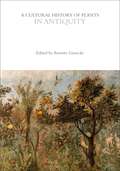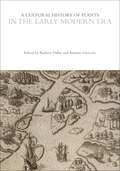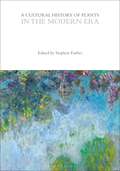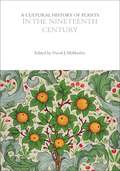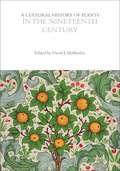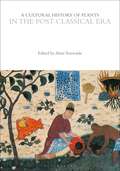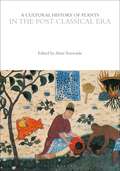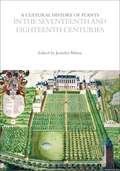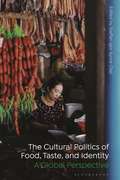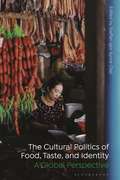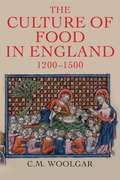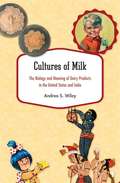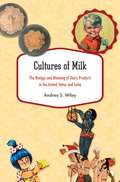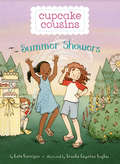- Table View
- List View
A Cultural History of Plants in Antiquity (The Cultural Histories Series)
by Annette GieseckeA Cultural History of Plants in Antiquity covers the period from 10,000 BCE to 500 CE. This period witnessed the transition from hunter-gatherer subsistence to the practice of agriculture in Mesopotamia and elsewhere, and culminated in the fall of the Roman Empire, the end of the Han Dynasty in China, the rise of Byzantium, and the first flowering of Mayan civilization. Human uses for and understanding of plants drove cultural evolution and were inextricably bound to all aspects of cultural practice. The growth of botanical knowledge was fundamental to the development of agriculture, technology, medicine, and science, as well as to the birth of cities, the rise of religions and mythologies, and the creation of works of literature and art. The 6 volume set of the Cultural History of Plants presents the first comprehensive history of the uses and meanings of plants from prehistory to today. The themes covered in each volume are plants as staple foods; plants as luxury foods; trade and exploration; plant technology and science; plants and medicine; plants in culture; plants as natural ornaments; the representation of plants. Annette Giesecke is Professor of Classics at the University of Delaware, USA. Volume 1 in the Cultural History of Plants set.General Editors: Annette Giesecke, University of Delaware, USA, and David Mabberley, University of Oxford, UK.
A Cultural History of Plants in Antiquity (The Cultural Histories Series)
A Cultural History of Plants in Antiquity covers the period from 10,000 BCE to 500 CE. This period witnessed the transition from hunter-gatherer subsistence to the practice of agriculture in Mesopotamia and elsewhere, and culminated in the fall of the Roman Empire, the end of the Han Dynasty in China, the rise of Byzantium, and the first flowering of Mayan civilization. Human uses for and understanding of plants drove cultural evolution and were inextricably bound to all aspects of cultural practice. The growth of botanical knowledge was fundamental to the development of agriculture, technology, medicine, and science, as well as to the birth of cities, the rise of religions and mythologies, and the creation of works of literature and art. The 6 volume set of the Cultural History of Plants presents the first comprehensive history of the uses and meanings of plants from prehistory to today. The themes covered in each volume are plants as staple foods; plants as luxury foods; trade and exploration; plant technology and science; plants and medicine; plants in culture; plants as natural ornaments; the representation of plants. Annette Giesecke is Professor of Classics at the University of Delaware, USA. Volume 1 in the Cultural History of Plants set.General Editors: Annette Giesecke, University of Delaware, USA, and David Mabberley, University of Oxford, UK.
A Cultural History of Plants in the Early Modern Era (The Cultural Histories Series)
by Andrew Dalby and Annette GieseckeA Cultural History of Plants in the Early Modern Era covers the period from 1400 to 1650, a time of discovery and rediscovery, of experiment and innovation. Renaissance learning brought ancient knowledge to modern European consciousness whilst exploration placed all the continents in contact with one another. The dissemination of knowledge was further speeded by the spread of printing. New staples and spices, new botanical medicines, and new garden plants all catalysed agriculture, trade, and science. The great medical botanists of the period attempted no less than what Marlowe's Dr Faustus demanded - a book “wherein I might see all plants, herbs, and trees that grow upon the earth.” Human impact on plants and our botanical knowledge had irrevocably changed. The 6 volume set of the Cultural History of Plants presents the first comprehensive history of the uses and meanings of plants from prehistory to today. The themes covered in each volume are plants as staple foods; plants as luxury foods; trade and exploration; plant technology and science; plants and medicine; plants in culture; plants as natural ornaments; the representation of plants. Andrew Dalby is an independent scholar and writer, based in France. Annette Giesecke is Professor of Classics at the University of Delaware, USA. Volume 3 in the Cultural History of Plants set.General Editors: Annette Giesecke, University of Delaware, USA, and David Mabberley, University of Oxford, UK.
A Cultural History of Plants in the Early Modern Era (The Cultural Histories Series)
A Cultural History of Plants in the Early Modern Era covers the period from 1400 to 1650, a time of discovery and rediscovery, of experiment and innovation. Renaissance learning brought ancient knowledge to modern European consciousness whilst exploration placed all the continents in contact with one another. The dissemination of knowledge was further speeded by the spread of printing. New staples and spices, new botanical medicines, and new garden plants all catalysed agriculture, trade, and science. The great medical botanists of the period attempted no less than what Marlowe's Dr Faustus demanded - a book “wherein I might see all plants, herbs, and trees that grow upon the earth.” Human impact on plants and our botanical knowledge had irrevocably changed. The 6 volume set of the Cultural History of Plants presents the first comprehensive history of the uses and meanings of plants from prehistory to today. The themes covered in each volume are plants as staple foods; plants as luxury foods; trade and exploration; plant technology and science; plants and medicine; plants in culture; plants as natural ornaments; the representation of plants. Andrew Dalby is an independent scholar and writer, based in France. Annette Giesecke is Professor of Classics at the University of Delaware, USA. Volume 3 in the Cultural History of Plants set.General Editors: Annette Giesecke, University of Delaware, USA, and David Mabberley, University of Oxford, UK.
A Cultural History of Plants in the Modern Era (The Cultural Histories Series)
by Stephen ForbesA Cultural History of Plants in the Modern Era covers the period from 1920 to today - a time when population growth, industrialization, global trade, and consumerism have fundamentally reshaped our relationship with plants. Advances in agriculture, science, and technology have revolutionised the ways we feed ourselves, whilst urbanization and industrial processing have reduced our direct connection with living plants. At the same time, our understanding of both ecology and conservation have greatly increased and our appreciation of the meanings and aesthetics of plants continue to suffuse art and everyday culture. The modern era has witnessed a revolution in both the valuation and the destruction of the natural world - more than ever before, we understand that the vitality of our relationship with plants will shape our future. The 6 volume set of the Cultural History of Plants presents the first comprehensive history of the uses and meanings of plants from prehistory to today. The themes covered in each volume are plants as staple foods; plants as luxury foods; trade and exploration; plant technology and science; plants and medicine; plants in culture; plants as natural ornaments; the representation of plants.Stephen Forbes is an independent scholar and writer, based in Australia. Volume 6 in the Cultural History of Plants set.General Editors: Annette Giesecke, University of Delaware, USA, and David Mabberley, University of Oxford, UK.
A Cultural History of Plants in the Modern Era (The Cultural Histories Series)
A Cultural History of Plants in the Modern Era covers the period from 1920 to today - a time when population growth, industrialization, global trade, and consumerism have fundamentally reshaped our relationship with plants. Advances in agriculture, science, and technology have revolutionised the ways we feed ourselves, whilst urbanization and industrial processing have reduced our direct connection with living plants. At the same time, our understanding of both ecology and conservation have greatly increased and our appreciation of the meanings and aesthetics of plants continue to suffuse art and everyday culture. The modern era has witnessed a revolution in both the valuation and the destruction of the natural world - more than ever before, we understand that the vitality of our relationship with plants will shape our future. The 6 volume set of the Cultural History of Plants presents the first comprehensive history of the uses and meanings of plants from prehistory to today. The themes covered in each volume are plants as staple foods; plants as luxury foods; trade and exploration; plant technology and science; plants and medicine; plants in culture; plants as natural ornaments; the representation of plants.Stephen Forbes is an independent scholar and writer, based in Australia. Volume 6 in the Cultural History of Plants set.General Editors: Annette Giesecke, University of Delaware, USA, and David Mabberley, University of Oxford, UK.
A Cultural History of Plants in the Nineteenth Century (The Cultural Histories Series)
by David J. MabberleyA Cultural History of Plants in the Nineteenth Century covers the period from 1800 to 1920, a time of astonishing growth in industrialization, urbanization, migration, population growth, colonial possessions, and developments in scientific knowledge. As European modes of civilization and cultivation were exported worldwide, botanical study was revolutionized – through the work of Charles Darwin and many others – and the new science of biology was born, based on cells, nuclei and molecules. As Darwinism took hold, plants came to be seen as a way of thinking about the connectivity of nature and life itself. The 6 volume set of the Cultural History of Plants presents the first comprehensive history of the uses and meanings of plants from prehistory to today. The themes covered in each volume are plants as staple foods; plants as luxury foods; trade and exploration; plant technology and science; plants and medicine; plants in culture; plants as natural ornaments; the representation of plants. David Mabberley is Emeritus Fellow at Wadham College, University of Oxford, UK; Emeritus Professor at the University of Leiden, The Netherlands; and Adjunct Professor at Macquarie University, Australia. Volume 5 in the Cultural History of Plants set.General Editors: Annette Giesecke, University of Delaware, USA, and David Mabberley, University of Oxford, UK.
A Cultural History of Plants in the Nineteenth Century (The Cultural Histories Series)
A Cultural History of Plants in the Nineteenth Century covers the period from 1800 to 1920, a time of astonishing growth in industrialization, urbanization, migration, population growth, colonial possessions, and developments in scientific knowledge. As European modes of civilization and cultivation were exported worldwide, botanical study was revolutionized – through the work of Charles Darwin and many others – and the new science of biology was born, based on cells, nuclei and molecules. As Darwinism took hold, plants came to be seen as a way of thinking about the connectivity of nature and life itself. The 6 volume set of the Cultural History of Plants presents the first comprehensive history of the uses and meanings of plants from prehistory to today. The themes covered in each volume are plants as staple foods; plants as luxury foods; trade and exploration; plant technology and science; plants and medicine; plants in culture; plants as natural ornaments; the representation of plants. David Mabberley is Emeritus Fellow at Wadham College, University of Oxford, UK; Emeritus Professor at the University of Leiden, The Netherlands; and Adjunct Professor at Macquarie University, Australia. Volume 5 in the Cultural History of Plants set.General Editors: Annette Giesecke, University of Delaware, USA, and David Mabberley, University of Oxford, UK.
A Cultural History of Plants in the Post-Classical Era (The Cultural Histories Series)
by Alain TouwaideA Cultural History of Plants in the Post-Classical Era covers the period from 500 to 1400, ranging across northern and central Europe to the Mediterranean, and from the Byzantine and Arabic Empires to the Persian World, India, and China. This was an age of empires and fluctuating borders, presenting a changing mosaic of environments, populations, and cultural practices. Many of the ancient uses and meanings of plants were preserved, but these were overlaid with new developments in agriculture, landscapes, medicine, eating habits, and art. The 6 volume set of the Cultural History of Plants presents the first comprehensive history of the uses and meanings of plants from prehistory to today. The themes covered in each volume are plants as staple foods; plants as luxury foods; trade and exploration; plant technology and science; plants and medicine; plants in culture; plants as natural ornaments; the representation of plants. Alain Touwaide is Scientific Director at the Institute for the Preservation of Medical Traditions, Washington, D.C., USA. Volume 2 in the Cultural History of Plants set.General Editors: Annette Giesecke, University of Delaware, USA, and David Mabberley, University of Oxford, UK.
A Cultural History of Plants in the Post-Classical Era (The Cultural Histories Series)
A Cultural History of Plants in the Post-Classical Era covers the period from 500 to 1400, ranging across northern and central Europe to the Mediterranean, and from the Byzantine and Arabic Empires to the Persian World, India, and China. This was an age of empires and fluctuating borders, presenting a changing mosaic of environments, populations, and cultural practices. Many of the ancient uses and meanings of plants were preserved, but these were overlaid with new developments in agriculture, landscapes, medicine, eating habits, and art.The six-volume set of the Cultural History of Plants presents the first comprehensive history of the uses and meanings of plants from prehistory to today. The themes covered in each volume are plants as staple foods; plants as luxury foods; trade and exploration; plant technology and science; plants and medicine; plants in culture; plants as natural ornaments; the representation of plants.Alain Touwaide is Scientific Director at the Institute for the Preservation of Medical Traditions, Washington, D.C., USA.A Cultural History of Plants in the Post-Classical Era is the second volume in the six-volume set, A Cultural History of Plants, also available online as part of Bloomsbury Cultural History, a fully-searchable digital library (see www.bloomsburyculturalhistory.com).General Editors: Annette Giesecke, University of Delaware, USA, and David Mabberley, University of Oxford, UK.
A Cultural History of Plants in the Seventeenth and Eighteenth Centuries (The Cultural Histories Series)
by Jennifer MilamA Cultural History of Plants in the Seventeenth and Eighteenth Centuries covers the period from 1650 to 1800,a time of global exploration and the discovery of new species of plants and their potential uses. Trade routes were established which brought Europeans into direct contact with the plants and people of Asia, Oceania, Africa and the Americas. Foreign and exotic plants become objects of cultivation, collection, and display, whilst the applications of plants became central not only to naturalists, landowners, and gardeners but also to philosophers, artists, merchants, scientists, and rulers. As the Enlightenment took hold, the natural world became something to be grasped through reasoned understanding. The 6 volume set of the Cultural History of Plants presents the first comprehensive history of the uses and meanings of plants from prehistory to today. The themes covered in each volume are plants as staple foods; plants as luxury foods; trade and exploration; plant technology and science; plants and medicine; plants in culture; plants as natural ornaments; the representation of plants. Jennifer Milam is Pro Vice-Chancellor and Professor of Art History, University of Newcastle, Australia. Volume 4 in the Cultural History of Plants set.General Editors: Annette Giesecke, University of Delaware, USA, and David Mabberley, University of Oxford, UK.
A Cultural History of Plants in the Seventeenth and Eighteenth Centuries (The Cultural Histories Series)
A Cultural History of Plants in the Seventeenth and Eighteenth Centuries covers the period from 1650 to 1800,a time of global exploration and the discovery of new species of plants and their potential uses. Trade routes were established which brought Europeans into direct contact with the plants and people of Asia, Oceania, Africa and the Americas. Foreign and exotic plants become objects of cultivation, collection, and display, whilst the applications of plants became central not only to naturalists, landowners, and gardeners but also to philosophers, artists, merchants, scientists, and rulers. As the Enlightenment took hold, the natural world became something to be grasped through reasoned understanding. The 6 volume set of the Cultural History of Plants presents the first comprehensive history of the uses and meanings of plants from prehistory to today. The themes covered in each volume are plants as staple foods; plants as luxury foods; trade and exploration; plant technology and science; plants and medicine; plants in culture; plants as natural ornaments; the representation of plants. Jennifer Milam is Pro Vice-Chancellor and Professor of Art History, University of Newcastle, Australia. Volume 4 in the Cultural History of Plants set.General Editors: Annette Giesecke, University of Delaware, USA, and David Mabberley, University of Oxford, UK.
The Cultural Politics of Food, Taste, and Identity: A Global Perspective
by Steffan Igor Ayora-DiazThe Cultural Politics of Food, Taste, and Identity examines the social, cultural, and political processes that shape the experience of taste. The book positions flavor as involving all the senses, and describes the multiple ways in which taste becomes tied to local, translocal, glocal, and cosmopolitan politics of identity. Global case studies are included from Japan, China, India, Belize, Chile, Guatemala, the United States, France, Italy, Poland and Spain. Chapters examine local responses to industrialized food and the heritage industry, and look at how professional culinary practice has become foundational for local identities. The book also discusses the unfolding construction of “local taste” in the context of sociocultural developments, and addresses how cultural political divides are created between meat consumption and vegetarianism, innovation and tradition, heritage and social class, popular food and authenticity, and street and restaurant food. In addition, contributors discuss how different food products-such as kimchi, quinoa, and Soylent-have entered the international market of industrial and heritage foods, connecting different places and shaping taste and political identities.
The Cultural Politics of Food, Taste, and Identity: A Global Perspective
The Cultural Politics of Food, Taste, and Identity examines the social, cultural, and political processes that shape the experience of taste. The book positions flavor as involving all the senses, and describes the multiple ways in which taste becomes tied to local, translocal, glocal, and cosmopolitan politics of identity. Global case studies are included from Japan, China, India, Belize, Chile, Guatemala, the United States, France, Italy, Poland and Spain. Chapters examine local responses to industrialized food and the heritage industry, and look at how professional culinary practice has become foundational for local identities. The book also discusses the unfolding construction of “local taste” in the context of sociocultural developments, and addresses how cultural political divides are created between meat consumption and vegetarianism, innovation and tradition, heritage and social class, popular food and authenticity, and street and restaurant food. In addition, contributors discuss how different food products-such as kimchi, quinoa, and Soylent-have entered the international market of industrial and heritage foods, connecting different places and shaping taste and political identities.
The Culture of Food in England, 1200-1500
by C. M. WoolgarIn this revelatory work of social history, C. M. Woolgar shows that food in late-medieval England was far more complex, varied, and more culturally significant than we imagine today. Drawing on a vast range of sources, he charts how emerging technologies as well as an influx of new flavors and trends from abroad had an impact on eating habits across the social spectrum. From the pauper’s bowl to elite tables, from early fad diets to the perceived moral superiority of certain foods, and from regional folk remedies to luxuries such as lampreys, Woolgar illuminates desire, necessity, daily rituals, and pleasure across four centuries.
The Cultured Club: Fabulous Funky Fermentation Recipes
by Dearbhla ReynoldsTurn Simple Ingredients Into Health GoldminesGut health is central to a strong immune system that is primed to fight off disease and preserve long-term optimal health. Eating fermented foods can have an extraordinary effect on your body and has been shown to benefit a number of health conditions including IBS and digestive difficulties, sugar/carb cravings, and other inflammatory disorders. Learning the art of fermentation allows you to become a kitchen chemist and experience the vibrant flavours of foods such as kimchi, sauerkraut, fermented salsa, kombucha and kefir.Fermentation is currently undergoing a huge revival as people recognise its health benefits and seek to learn more about the craft, and the science behind it. In The Cultured Club, fermentation expert Dearbhla Reynolds teaches you how to turn simple ingredients into superfoods by using one of the world’s oldest methods of food preservation.Includes:Introduction and brief history of fermentationGut healthBasic techniquesBeverages such as kefir and kombuchaSnacks/light lunchesMealsDessertsBecome a kitchen chemist and discover the benefits of fermented foods!
Cultures of Milk: The Biology And Meaning Of Dairy Products In The United States And India
by Andrea S. WileyAndrea Wiley contrasts the practices of the world's leading milk producers, India and the United States. In both countries, milk is considered to have special qualities. Drawing on ethnographic and scientific studies, popular media, and government reports, she shows that the cultural significance of milk goes well beyond its nutritive value.
Cultures of Milk: The Biology And Meaning Of Dairy Products In The United States And India
by Andrea S. WileyAndrea Wiley contrasts the practices of the world's leading milk producers, India and the United States. In both countries, milk is considered to have special qualities. Drawing on ethnographic and scientific studies, popular media, and government reports, she shows that the cultural significance of milk goes well beyond its nutritive value.
Cupcake Heaven
by Susannah BlakeCute, colorful, and endlessly diverse, cupcakes never fail to please. Susannah Blake brings together more than 50 simple recipes, as well as giving the lowdown on baking Equipment, Ingredients, Decorating and Embellishments and Serving Suggestions. Simple Cupcakes show how easy it is to rustle up a plateful of orange and poppyseed,or apple and cinnamon cupcakes. From weddings and christenings, to Christmas and Halloween, Celebrations Cupcakes have perfect ideas to cater for all events. For a dose of decadence, try an Indulgent Cupcake like lemon meringue or strawberry cheesecake. Cupcakes for Special Diets allow you to give in to your cupcake cravings even if you follow a dairy-free, nut-free, gluten-free or low-fat diet. Involve the little ones by helping them bake their own Kids Cupcakes, easy enough for children to make with adult help. Susannah Blake has written a number of books, including Afternoon Tea, Cucpakes, Cupcake Heaven, Afternoon Tea Parties and Say It With a Cupcake for Ryland Peters & Small, and her work also appears in Livingetc, OK! and She magazines. A passionate traveller, explorer and diner, Susannah has been all over the world. She loves to draw on her experiences of different cuisines, bringing together the ingredients, flavours and techniques in her own relaxed and inspired approach to food.
Cupcake Heaven
by Susannah BlakeCute, colorful, and endlessly diverse, cupcakes never fail to please. Susannah Blake brings together more than 50 simple recipes, as well as giving the lowdown on baking Equipment, Ingredients, Decorating and Embellishments and Serving Suggestions. Simple Cupcakes show how easy it is to rustle up a plateful of orange and poppyseed,or apple and cinnamon cupcakes. From weddings and christenings, to Christmas and Halloween, Celebrations Cupcakes have perfect ideas to cater for all events. For a dose of decadence, try an Indulgent Cupcake like lemon meringue or strawberry cheesecake. Cupcakes for Special Diets allow you to give in to your cupcake cravings even if you follow a dairy-free, nut-free, gluten-free or low-fat diet. Involve the little ones by helping them bake their own Kids Cupcakes, easy enough for children to make with adult help. Susannah Blake has written a number of books, including Afternoon Tea, Cucpakes, Cupcake Heaven, Afternoon Tea Parties and Say It With a Cupcake for Ryland Peters & Small, and her work also appears in Livingetc, OK! and She magazines. A passionate traveller, explorer and diner, Susannah has been all over the world. She loves to draw on her experiences of different cuisines, bringing together the ingredients, flavours and techniques in her own relaxed and inspired approach to food.
Cupcake (Large Print)
This is a picture of a cupcake. It is in the middle of the page. There is a locator dot shown, which will be at the top left of the page when the image is the correct way up. At the top of the picture a glace cherry is sitting on some pink sugar icing. Below this is the cake overflowing the top of the paper cup below.
Cupcake (UEB Contracted)
This is a picture of a cupcake. It is in the middle of the page. There is a locator dot shown, which will be at the top left of the page when the image is the correct way up. At the top of the picture a glace cherry is sitting on some pink sugar icing. Below this is the cake overflowing the top of the paper cup below.
Cupcake (UEB Uncontracted)
This is a picture of a cupcake. It is in the middle of the page. There is a locator dot shown, which will be at the top left of the page when the image is the correct way up. At the top of the picture a glace cherry is sitting on some pink sugar icing. Below this is the cake overflowing the top of the paper cup below.
Cupcakes!: From the Cake Mix Doctor
by Anne ByrnThe cupcake is America’s darling. It’s celebrated in upscale bakeries, on Sex in the City, on the cover of Gourmet, and in thou-sands of classrooms—where every day, it seems, a parent has sent in a batch for the kids to share. The very word conjures up whimsy, coziness, pleasure, nostalgia. Not to mention the fact that their diminutive size means you can eat a lot of them. Once upon a time, a family had only two recipes for cupcakes—chocolate and vanilla. Not anymore. Now Anne Byrn brings them to the next level. And who better? Recognized as the master of cake-mix baking, Anne is the author of The Cake Mix Doctor and Chocolate from the Cake Mix Doctor, which have a total of over 1.8 million copies in print. In Cupcakes she offers 135 tempting recipes for children and grown-ups, for special days and everyday, lunch bags, holiday festivities, and an unexpected dinner party dessert. You’ll never believe these artful little cakes started with a mix. Coconut Snowballs, Jelly Doughnut Cupcakes, Kiss Me Cakes, Warm Chocolate Cupcakes with Molten Centers, Red Velvet Cupcakes with White Chocolate Peppermint Cream Cheese Frosting. There are surprising additions (tuck a chocolate kiss orpiece of cookie dough into the batter). Creative toppings and easy from-scratch frostings (whipped cream spiked with Kahlua; miniature M&Ms; a creamy malted frosting with crushed malted milk balls).Terrific decorating ideas, from glittering golden dragees or elegant chocolate curls to yellow peeps for an Easter cupcake or—for Groundhog’s Day—a groundhog’s face made out of chocolate frosting and jimmies. Includes a 16-page full-color opening essay.
